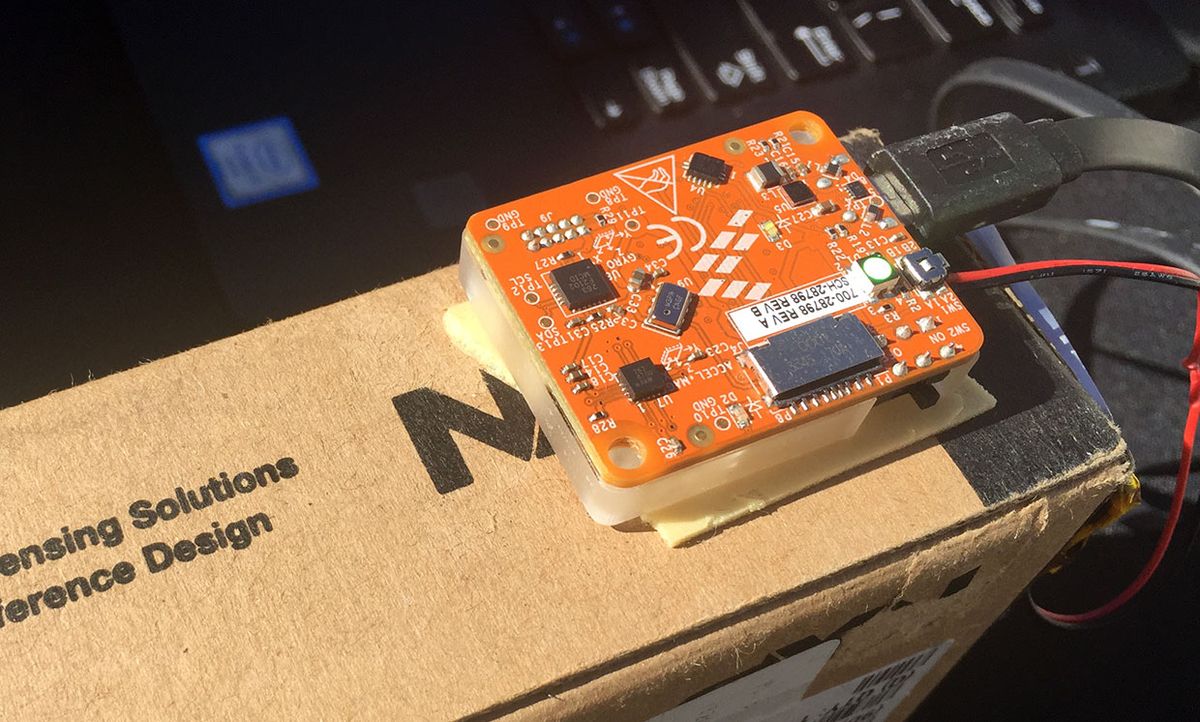Every year, the MEMS & Sensors Industry Group (MSIG) puts out a call for new, innovative gadgets that show off the latest capabilities of devices, including accelerometers, gyroscopes, and microphones.
This year, MSIG selected five gadgets to show off at its annual Executive Congress, held this week in Napa, Calif. They included chip-scale gas sensors from N5 Sensors; a behind-the-ear wearable concussion and biometric monitor from SportFitz; and hockey skates with built in sensors for tracking the way a skater moves, plus smartphone-based analytics for judging the quality of the movement, from Scorched Ice.
For me, though, one of the standouts was NXP Semiconductor’s package-abuse tracker, probably because it could be used to answer a question we’ve all asked ourselves when a bashed-up package is delivered: “What in the world happened?”
NXP Semiconductor’s Sahil Choudhary pitched the gadget as an “asset-tracking technology,” but it doesn’t so much tell you where a package is, as much as how it’s being treated—that is, dropped, tossed, flipped around, or otherwise roughly handled. The current design, Choudhary said, includes nine-axis motion sensing, a pressure sensor, a low-power microcontroller, an SD card, and a battery; these are enough to keep a log of what happens to the package and when. Future generations, he expects, would include NFC communications so the data could be read by scanning, instead of by removing the SD card and inserting it into a computer.
The bad news? It’s got a bit of a way to go before becoming a product. Choudhary said NXP Semiconductor is just planning to offer reference designs, in hopes that the gadget will be manufactured by others, perhaps the kinds of companies that make RFID tags for tracking.
The other standout in the showcase: Alertgy’s noninvasive method of monitoring changes in blood glucose. The best noninvasive blood glucose monitor I’d seen in operation previously was a dog. Mark Rippen, CEO of Alertgy and former director of engineering for SRI International’s Space and Marine Technology Group, said his company is projecting a low-power RF field into a user’s wrist and then using a sensor to monitor changes in the RF field. The system then determines blood glucose through dielectric spectroscopy—that is, measuring the dielectric properties of the body as a function of frequency.
Essentially, says Rippen, “the sensor acts as if it were embedded under the skin.” (It does have to be calibrated using traditional blood glucose testing strips for each user.)
Alertgy’s system then uses a smartphone to display the glucose levels and alert the user—and an emergency contact if necessary—if blood sugar levels appear to be in a danger zone. Rippen said that Alertgy is working with the Cleveland Clinic to validate its technology. After validation, Alertgy will have to turn what is currently a not-very-wearable prototype into something that can be comfortably worn for an extended period.
Tekla S. Perry is a senior editor at IEEE Spectrum. Based in Palo Alto, Calif., she's been covering the people, companies, and technology that make Silicon Valley a special place for more than 40 years. An IEEE member, she holds a bachelor's degree in journalism from Michigan State University.



